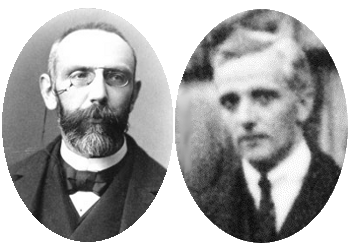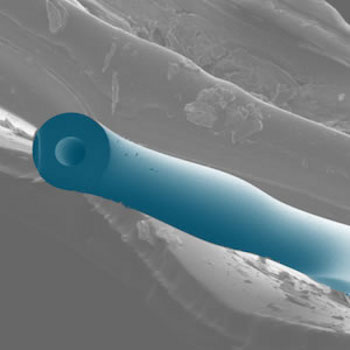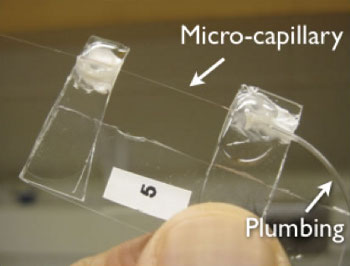Brillouin Microfluidics
June 28, 2013
The
French physicist,
Léon Brillouin (1889-1969), who came of
scientific age during a
golden era of
physics, contributed to many of its topic areas. He studied under
Arnold Sommerfeld and
Paul Langevin, and
Marie Curie was part of the
academic committee that certified him for his
Docteur ès Science in 1920.
Phonons, which are
quantized acoustic vibrations in
solids, were a part of Brillouin's
doctoral dissertation.

Like father, like son.
Léon Brillouin's father, Marcel (left), was also a physicist.
(Source images, left and right, via Wikimedia Commons.)
Phonons will gently expand and compress regions of an
optical crystal, and this will affect its refractive index. Such a change in the refractive index causes a small scattering of light, now known as
Brillouin scattering. Since acoustic waves have a wavelength, they will produce a periodic variation in
refractive index, effectively producing a shallow
diffraction grating. Additionally, if the acoustic
wave is not part of a
resonator, it's not a
standing wave, so the grating is moving and it will
Doppler shift the light.
Brillouin scattering is quite weak, but the advent of
lasers, modern light
detectors and advanced
signal processing make many Brillouin scattering
experiments practical. I wrote about one of these in an article earlier this year (
Spider Silk Mechanics, February 15, 2013). A
research team from the
Department of Chemistry and Biochemistry,
Arizona State University (
Tempe, Arizona) has been investigating strands of
spider silk by Brillouin light scattering.[1-2]
A
mechanical engineer from the
University of Illinois at Urbana-Champaign has teamed with
electrical engineers and
biomedical engineers from the
University of Michigan, Ann Arbor, to apply Brillouin scattering to the coupling of phonons and
photons in
liquids.[3-4] Such experiments have been hitherto challenging, since immersion of optomechanical components into a liquid
dampens the acoustic vibrations. The acoustic energy leaks out to the liquid surrounding the device.
The Illinois-Michigan research team has gotten around this problem by putting the liquids into hollow
capillaries. This allowed the optical excitation of mechanical
whispering-gallery modes at
frequencies from 2
MHz to 11
GHz.[3-4] The light is coupled to the liquid from the outer, dry side of the capillary, and the liquids are brought into the capillary by a standard
microfluidic inlet.[3] This experiment builds on their experience in a previous study in which they excited whispering-gallery type mechanical resonances in 100
micrometer diameter silica microspheres in a frequency range of 49 MHz to 1.4 GHz using forward Brillouin scattering .[5]

Scanning electron micrograph of a microfluidic optomechanical capillary resonator with false color highlighting the capillary resonator.
(University of Illinois image.)[4)]
![]()

Microfluidic optomechanical capillary resonator in a mounting with its fluid control tubing.
(University of Illinois image.)[4)]
The capillaries care made from
fused silica glass, and the optical whispering gallery modes enhance the
intensity of the
force resulting from the optical excitation by many
orders-of-magnitude. This allows a greater interaction between photons and phonons. Strong phonon-photon coupling is interesting, since it enables experiments in
quantum information storage,
optomechanical cooling, and ultra-sensitive force measurements.[4]
Says
Gaurav Bahl, an
assistant professor of
mechanical science and engineering at the University of Illinois and lead author of the paper describing this work,
"Optomechanics is an area of research in which extremely minute forces exerted by light (for example: radiation pressure, gradient force, electrostriction) are used to generate and control high-frequency mechanical vibrations of microscale and nanoscale devices... In particular, the high frequency, high quality-factor mechanical vibrations demonstrated in this work may enable strongly localized, high-sensitivity, optomechanical interaction with chemical and biological samples."[4]
This technology has some potential applications, such as optomechanical
biosensors for measuring the optical and mechanical properties of single
cells, rapid analysis of fluids, and optical control of
fluid flow.[4] The Illinois research team is investigating this technology for building biosensors.[4] Brillouin scattering has been shown also to attenuate the
Brownian motion of microscopic
acoustic resonators.[6-7]
References:
- Kristie J. Koski, Paul Akhenblit, Keri McKiernan and Jeffery L. Yarger, "Non-invasive determination of the complete elastic moduli of spider silks," Nature Materials, Published Online, January 27, 2013, doi:10.1038/nmat3549.
- Andrew Myers, "Stanford Researcher Sheds New Light on the Mysteries of Spider Silk, Stanford University Press Release, February 4, 2013.
- Gaurav Bahl, Kyu Hyun Kim, Wonsuk Lee, Tal Carmon, Wonsuk Lee, Jing Liu and Xudong Fan, "Brillouin cavity optomechanics with microfluidic devices," Nature Communications, vol. 4, article no. 1994, doi:10.1038/ncomms2994, June 7, 2013.
- Rick Kubetz, "Whispering light hears liquids talk," University of Illinois Press Release, June 7, 2013.
- Gaurav Bahl, John Zehnpfennig, Matthew Tomes and Tal Carmon, "Stimulated optomechanical excitation of surface acoustic waves in a microdevice," Nature Communications, vol. 2, article no. 403, doi:10.1038/ncomms1412, July 26, 2011.
- Gaurav Bahl, Matthew Tomes, Florian Marquardt and Tal Carmon, "Observation of spontaneous Brillouin cooling," Bahl et al, Nature Physics, vol.8, no.3 (January 22, 2012), pp. 203-207.
- Ivan Favero, "Optomechanics: The stress of light cools vibration," Bahl et al, Nature Physics, vol.8, no.3 (January 22, 2012), pp. 180-181.
Permanent Link to this article
Linked Keywords: French; physicist; Léon Brillouin (1889-1969); science; scientific; golden age; golden era; physics; Arnold Sommerfeld; Paul Langevin; Marie Curie; academia; academic; committee; Doctor of Science; Docteur ès Science; phonon; quantization; quantized; acoustics; acoustic; vibration; solid; thesis; doctoral dissertation; Marcel Brillouin; Solvay conference 1927; optics; optical; crystal; Brillouin scattering; refractive index; diffraction grating; wave; resonator; standing wave; Doppler shift; laser; sensor; detector; signal processing; experiment; research; Department of Chemistry and Biochemistry; Arizona State University; Tempe, Arizona; spider silk; mechanical engineering; mechanical engineer; University of Illinois at Urbana-Champaign; electrical engineering; electrical engineer; biomedical engineering; biomedical engineer; University of Michigan, Ann Arbor; photon; liquid; damping; dampen; capillary action; capillary; whispering-gallery mode; frequency; hertz; MHz; GHz; microfluidic; micrometer; diameter; silicon dioxide; silica; microsphere; fused silica glass; intensity; force; order-of-magnitude; qubit; quantum information storage; optomechanical cooling; Gaurav Bahl; assistant professor; mechanical science and engineering; biosensor; cell; fluid dynamics; fluid flow; Brownian motion; acoustic resonator.